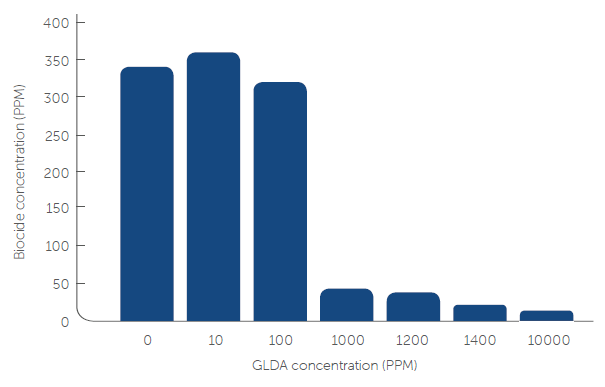Enhanced TDS
Identification & Functionality
- Chemical Name
- Agrochemical Functions
- Cleaning Ingredients Functions
- Cosmetic Ingredients Functions
- Industrial Additives Functions
- Molecular formula
- GLDA - Na₄
- Technologies
- Product Families
- Chemical Structure

Features & Benefits
- Benefit Claims
- Labeling Claims
- HII Features
- Personal Care Benefits
An important ingredient in Personal Care formulations provides benefits that include
- Enhancing the effectiveness of biological preservatives
- Use less preservatives
- Effective on molds and both gram positive and gram negative bacteria
- Hard water management
- Improved foam
- Better cleansing
- Improved shelf life and product appearance
- Preventing rancidity
- Protecting the intended color and odor of your formulation
- Enhancing the effectiveness of biological preservatives
Applications & Uses
- Markets
- Applications
- Applicable Processes
- Home Care Applications
- I&I Cleaning Applications
- Product Applications
- Boosting agent for disinfecting products (with low skin irritation) Improved detergency at high water hardness Hard surface cleaning performance is improved in combination with gluco(hepto)nates Scale removal at high pH Scale inhibitor in laundering and dishwashing applications.
- Booster for stain removal in dish washing detergents better than citrates and phosphates Scum inhibitor in bathroom cleaners Improved cleaning & foaming in shampoo applications.
- Storage stabilization of bleaching agents (perborates / percarbonates) and unsaturated alkyl chain based surfactants.
- Transport cleaners: Oil and Iron removal at high pH replacement for NTA
Properties
- Physical Form
- Appearance
- Clear liquid
- Odor
- Slightly ammonia like
- Miscible in
- Water, low pH, ethylene glycol, 5M NaOH (at 20°C)
- Characteristics
Value Units Test Method / Conditions Crystallization Point max. -15 °C - Electro Conductivity approx. 4.75 mS/cm - NTA-Na₃ Content max. 0.1 % - Viscosity (at 20°C) 90 - 150 mPa·s - Freezing Point max. -15 °C - Chemical Oxygen Demand 345 - 385 mg/g - - Specifications
Value Units Test Method / Conditions Molecular Weight 351.1 - - Assay (as GLDA-Na₄) min. 47.4 % - Color max. 250 - APHA Density approx. 1400 kg/m³ - NTA-Na₃ Content max. 0.1 % - pH (at 1% w/v Dilution) 11.0 - 11.8 - - - Theoretical Properties
Value Units Test Method / Conditions Sequestering Values (Calcium ion, at pH 6 - 14) approx. 55 mg metal/g - Sequestering Values (Copper ion, at pH 2-12) approx. 85 mg metal/g - Sequestering Values (Ferric ion, at pH 2-8) approx. 75 mg metal/g - Sequestering Values (Magnesium ion, at pH 5-10) approx. 35 mg metal/g - Sequestering Values (Manganese ion, at pH 5-10) approx. 75 mg metal/g - Sequestering Values (Zinc ion, at pH 3-12) approx. 90 mg metal/g -
Regulatory & Compliance
- Certifications & Compliance
- Chemical Inventories
Technical Details & Test Data
- Biocide and Preservatives Performance Test Data
Dissolvine GL-47-S is an important ingredient in formulations providing benefits that enhance the effectiveness of biocides and biological preservatives. Dissolvine GL-47-S is effective on molds and both Gram-positive and Gram-negative bacteria. When you include Dissolvine GL-47-S in the formulations, you can significantly reduce the amount of activity needed while preserving efficacy and saving on formulation costs.

Species is deprived of multivalent cations weakening the outer surface and more vunerable for the action of preservatives
Amount of Arquad® MCB-50 needed to obtain 99.9% kill (Pseudomonas aeruginosa)

Studies performed by a third-party laboratory on Pseudonomas aeruginosa, Aspergilis niger and Staphylococcus aureus have demonstrated the following:- With common preservatives, a savings of up to 30% was typically observed
- With benzoic acid, a savings of up to 90% was possible.
- Density Data
Liquid density The density of the liquid can be used as a quick reference to check the concentration of the material. See Figure 1.
Figure 1: Density of Dissolvine® GL plotted against GLDA-Na4 concentration based on GL-38, GL-47-S and GL Premium.

- Viscosity Data
Viscosity is an important parameter for handling products and is dependent on concentration and temperature. Figure 2 shows the viscosity of various concentrations of GLDA-Na4 solutions as a function of temperature.
Figure 2: Graph of the viscosity of various concentrations of Dissolvine® GL at different temperatures compared to the viscosity of Dissolvine® GL Premium.

Packaging & Availability
Storage & Handling
- Storage & Retest Information
Store in original packing or in PVC, PP, PE, stainless steel or bituminized tanks. Avoid contact with aluminum, zinc, nickel, copper and copper alloys. It is advised to re-test the material after three years of storage.
